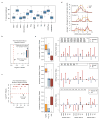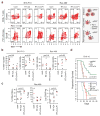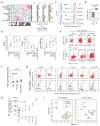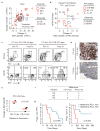Radiation and dual checkpoint blockade activate non-redundant immune mechanisms in cancer
- PMID: 25754329
- PMCID: PMC4401634
- DOI: 10.1038/nature14292
Radiation and dual checkpoint blockade activate non-redundant immune mechanisms in cancer
Abstract
Immune checkpoint inhibitors result in impressive clinical responses, but optimal results will require combination with each other and other therapies. This raises fundamental questions about mechanisms of non-redundancy and resistance. Here we report major tumour regressions in a subset of patients with metastatic melanoma treated with an anti-CTLA4 antibody (anti-CTLA4) and radiation, and reproduced this effect in mouse models. Although combined treatment improved responses in irradiated and unirradiated tumours, resistance was common. Unbiased analyses of mice revealed that resistance was due to upregulation of PD-L1 on melanoma cells and associated with T-cell exhaustion. Accordingly, optimal response in melanoma and other cancer types requires radiation, anti-CTLA4 and anti-PD-L1/PD-1. Anti-CTLA4 predominantly inhibits T-regulatory cells (Treg cells), thereby increasing the CD8 T-cell to Treg (CD8/Treg) ratio. Radiation enhances the diversity of the T-cell receptor (TCR) repertoire of intratumoral T cells. Together, anti-CTLA4 promotes expansion of T cells, while radiation shapes the TCR repertoire of the expanded peripheral clones. Addition of PD-L1 blockade reverses T-cell exhaustion to mitigate depression in the CD8/Treg ratio and further encourages oligoclonal T-cell expansion. Similarly to results from mice, patients on our clinical trial with melanoma showing high PD-L1 did not respond to radiation plus anti-CTLA4, demonstrated persistent T-cell exhaustion, and rapidly progressed. Thus, PD-L1 on melanoma cells allows tumours to escape anti-CTLA4-based therapy, and the combination of radiation, anti-CTLA4 and anti-PD-L1 promotes response and immunity through distinct mechanisms.
Conflict of interest statement
The authors declare no competing financial interests. Code for computational analysis is available upon request.
Figures










Comment in
-
PD-L1 Upregulation Drives Escape from Anti-CTLA4 and Radiation Therapy.Cancer Discov. 2015 May;5(5):OF13. doi: 10.1158/2159-8290.CD-RW2015-049. Epub 2015 Mar 19. Cancer Discov. 2015. PMID: 25790979 No abstract available.
-
Immunotherapy: Combined immunoradiotherapy reinvigorates antitumour immunity.Nat Rev Clin Oncol. 2015 Jun;12(6):311. doi: 10.1038/nrclinonc.2015.54. Epub 2015 Mar 24. Nat Rev Clin Oncol. 2015. PMID: 25801818 No abstract available.
-
Tumour immunology: A triple blow for cancer.Nat Rev Immunol. 2015 May;15(5):265. doi: 10.1038/nri3844. Epub 2015 Mar 27. Nat Rev Immunol. 2015. PMID: 25814401 No abstract available.
-
Immunotherapy: A triple blow for cancer.Nat Rev Cancer. 2015 May;15(5):258-9. doi: 10.1038/nrc3946. Epub 2015 Apr 2. Nat Rev Cancer. 2015. PMID: 25833214 No abstract available.
-
Radiotherapy complements immune checkpoint blockade.Cancer Cell. 2015 Apr 13;27(4):437-8. doi: 10.1016/j.ccell.2015.03.015. Cancer Cell. 2015. PMID: 25873170
-
Radiotherapy and immune checkpoint blockade: potential interactions and future directions.Trends Mol Med. 2015 Aug;21(8):463-5. doi: 10.1016/j.molmed.2015.05.007. Epub 2015 Jun 16. Trends Mol Med. 2015. PMID: 26091823
Similar articles
-
PD-L1 Upregulation Drives Escape from Anti-CTLA4 and Radiation Therapy.Cancer Discov. 2015 May;5(5):OF13. doi: 10.1158/2159-8290.CD-RW2015-049. Epub 2015 Mar 19. Cancer Discov. 2015. PMID: 25790979 No abstract available.
-
Radiotherapy complements immune checkpoint blockade.Cancer Cell. 2015 Apr 13;27(4):437-8. doi: 10.1016/j.ccell.2015.03.015. Cancer Cell. 2015. PMID: 25873170
-
Radiotherapy and immune checkpoint blockade: potential interactions and future directions.Trends Mol Med. 2015 Aug;21(8):463-5. doi: 10.1016/j.molmed.2015.05.007. Epub 2015 Jun 16. Trends Mol Med. 2015. PMID: 26091823
-
T cell checkpoint regulators in the heart.Cardiovasc Res. 2019 Apr 15;115(5):869-877. doi: 10.1093/cvr/cvz025. Cardiovasc Res. 2019. PMID: 30721928 Free PMC article. Review.
-
Immune checkpoints and their inhibition in cancer and infectious diseases.Eur J Immunol. 2017 May;47(5):765-779. doi: 10.1002/eji.201646875. Epub 2017 Apr 24. Eur J Immunol. 2017. PMID: 28393361 Review.
Cited by
-
Effect of CMNa combined with radiotherapy on the tumor immune microenvironment of mouse cervical cancer cell transplantation tumor model.Bioengineered. 2021 Dec;12(1):1066-1077. doi: 10.1080/21655979.2021.1899532. Bioengineered. 2021. PMID: 33784955 Free PMC article.
-
Autophagy inhibition is the next step in the treatment of glioblastoma patients following the Stupp era.Cancer Gene Ther. 2021 Sep;28(9):971-983. doi: 10.1038/s41417-020-0205-8. Epub 2020 Aug 5. Cancer Gene Ther. 2021. PMID: 32759988 Review.
-
Radiation and CAR T-cell Therapy in Lymphoma: Future Frontiers and Potential Opportunities for Synergy.Front Oncol. 2021 Mar 25;11:648655. doi: 10.3389/fonc.2021.648655. eCollection 2021. Front Oncol. 2021. PMID: 33842363 Free PMC article. Review.
-
A Review of the Abscopal Effect in the Era of Immunotherapy.Cureus. 2022 Sep 26;14(9):e29620. doi: 10.7759/cureus.29620. eCollection 2022 Sep. Cureus. 2022. PMID: 36321062 Free PMC article. Review.
-
Epigenetic Regulation in Oral Squamous Cell Carcinoma Microenvironment: A Comprehensive Review.Cancers (Basel). 2023 Nov 27;15(23):5600. doi: 10.3390/cancers15235600. Cancers (Basel). 2023. PMID: 38067304 Free PMC article. Review.
References
Publication types
MeSH terms
Substances
Associated data
- Actions
Grants and funding
- R01 CA163739/CA/NCI NIH HHS/United States
- R01CA158186/CA/NCI NIH HHS/United States
- P01AI112521/AI/NIAID NIH HHS/United States
- P50CA174523/CA/NCI NIH HHS/United States
- U19 AI082630/AI/NIAID NIH HHS/United States
- P01 AI112521/AI/NIAID NIH HHS/United States
- P50 CA174523/CA/NCI NIH HHS/United States
- R01 CA158186/CA/NCI NIH HHS/United States
- R01 CA169123/CA/NCI NIH HHS/United States
- R01 CA169134/CA/NCI NIH HHS/United States
- R01CA163739/CA/NCI NIH HHS/United States
- P30 CA016520/CA/NCI NIH HHS/United States
- U19AI082630/AI/NIAID NIH HHS/United States
- R01AI105343/AI/NIAID NIH HHS/United States
- P30CA016520/CA/NCI NIH HHS/United States
- UL1RR024134/RR/NCRR NIH HHS/United States
- T32DK007066/DK/NIDDK NIH HHS/United States
- KL2TR000139/TR/NCATS NIH HHS/United States
- R01 AI105343/AI/NIAID NIH HHS/United States
- T32 DK007066/DK/NIDDK NIH HHS/United States
- U01 AI095608/AI/NIAID NIH HHS/United States
- R01 CA172651/CA/NCI NIH HHS/United States
- R01CA172651/CA/NCI NIH HHS/United States
- U01AI095608/AI/NIAID NIH HHS/United States
- UL1 RR024134/RR/NCRR NIH HHS/United States
- KL2 TR000139/TR/NCATS NIH HHS/United States
LinkOut - more resources
Full Text Sources
Other Literature Sources
Medical
Molecular Biology Databases
Research Materials

